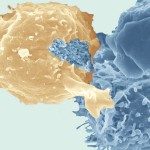Link to Pubmed [PMID] – 28357658
Methods Mol. Biol. 2017;1582:3-24
We estimated that at least 5-10 million individuals are infected with HTLV-1. Importantly, this number is based on the study of nearly 1.5 billion people living in known human T-cell lymphotropic virus type 1 (HTLV-1) endemic areas, for which reliable epidemiological data are available. However, for some highly populated regions including India, the Maghreb, East Africa, and some regions of China, no consistent data are yet available which prevents a more accurate estimation. Thus, the number of HTLV-1 infected people in the world is probably much higher. The prevalence of HTLV-1 prevalence varies depending on age, sex, and economic level in most HTLV-1 endemic areas. HTLV-1 seroprevalence gradually increases with age, especially in women. HTLV-1 has a simian origin and was originally acquired by humans through interspecies transmission from STLV-1 infected monkeys in the Old World. Three main modes of HTLV-1 transmission have been described; (1) from mother-to-child after prolonged breast-feeding lasting more than six months, (2) through sexual intercourse, which mainly, but not exclusively, occurs from male to female and lastly, (3) from contaminated blood products, which contain HTLV-1 infected lymphocytes. In specific areas, such as Central Africa, zoonotic transmission from STLV-1 infected monkeys to humans is still ongoing.The diagnostic methods used to study the epidemiological aspects of HTLV-1 infection mainly consist of serological assays for the detection of antibodies specifically directed against different HTLV-1 antigens. Screening tests are usually based on enzyme-linked immunoabsorbent assay (ELISA), chemiluminescence enzyme-linked immunoassay (CLEIA) or particle agglutination (PA). Confirmatory tests include mostly Western blots (WB)s or innogenetics line immunoassay (INNO-LIA™) and to a lesser extent immunofluorescence assay (IFA). The search for integrated provirus in the DNA from peripheral blood cells can be performed by qualitative and/or quantitative polymerase chain reaction (qPCR). qPCR is widely used in most diagnostic laboratories and quantification of proviral DNA is useful for the diagnosis and follow-up of HTLV-1 associated diseases such as adult T-cell leukemia (ATL) and tropical spastic paraparesis/HTLV-1 associated myelopathy (TSP/HAM). PCR also provides amplicons for further sequence analysis to determine the HTLV-1 genotype present in the infected person. The use of new generation sequencing methodologies to molecularly characterize full and/or partial HTLV-1 genomic regions is increasing. HTLV-1 genotyping generates valuable molecular epidemiological data to better understand the evolutionary history of this virus.

